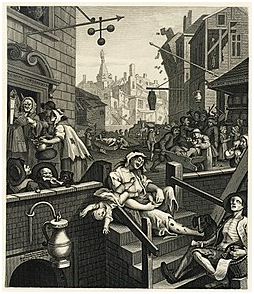
This was the title of the December talk of the Sawston Village History Society, although in spite of the month, there were no free samples. The sub-title was "The Life and Times of Madame Geneva".
The gin craze began at the time of The Glorious Revolution in which the Dutch prince William of Orange and his wife Mary became joint monarchs when the strongly catholic King James was overthrown by the British political elite.
At this time gin was already being produced in England, having been discovered by British Navy sailors when they were supporting the Dutch war of independence in 1568. The Dutch were accustomed to take a drink before going into action to give them "Dutch Courage". High taxes on imports of other spirits encouraged increased home production of gin to half a million gallons per year. Enter Madam Geneva. In London a dram of gin could be bought for a penny at any one of nearly 7000 gin shops. The poor drank it because it was cheap, it was a relief from hunger pangs and cold, and provided oblivion. In a Hogarth cartoon, a gin palace has a sign over the door saying "Drunk for a penny, dead drunk for two pence, clean straw for nothing". Whether they woke again was only a matter of time.

Gin Lane - Hogarth
(Note: The phrase "Saved by the bell" is said to come from this time. Many people became paranoid about being buried alive so they wrote instructions for Safety Coffins in their Wills. These included a bell to attract the cemetery night watchman should a buried body awake from an intoxicated coma. It is said that the practice of a 24 hour "wake" also stems from this paranoia.)
A 1721 pamphlet mentions that "not far from Smithfield, a trader has a large empty room where, as his guests get intoxicated, they are laid together in heaps, men, women, and children, until they recover their senses, when they proceed to drink on, or having spent all they had, go out to find the means to return to the same dreadful pursuit".
It is hard to understand this gin epidemic from today's world. Two factors may help to explain it. Europe was then in "The Mini Ice Age" with the Thames commonly freezing over completely. Secondly, hygiene conditions were poor and clean drinking water not widely available.
When the government finally passed the first Gin Act in 1736, there were riots all over the country, and mock funeral processions in protest at "The death of Madam Geneva". However gin madness continued to rise to an all time high in 1743 when it was recorded that 2.2 gallons was consumed per person of all ages per year.
A further seven Gin Acts were passed over the next 30 years to try to get on top of the gin problem by regulation and taxation, and by 1760 drinkers began to switch to beer.
Jim Butchart